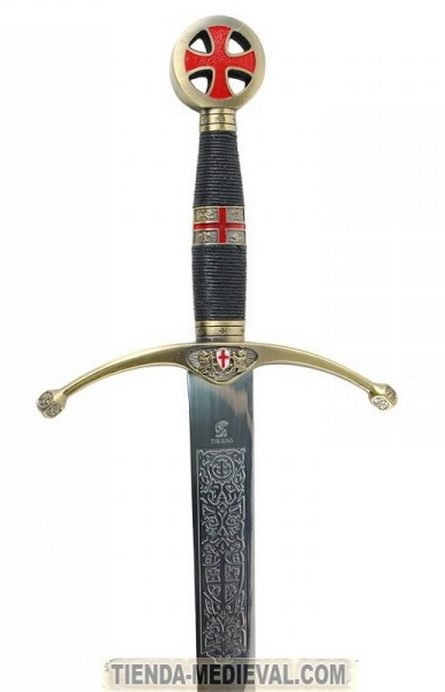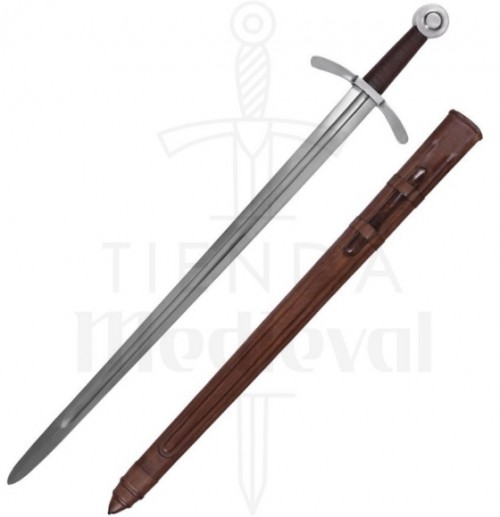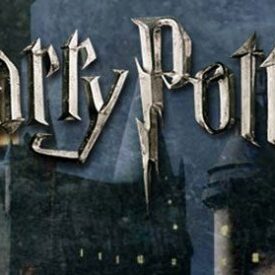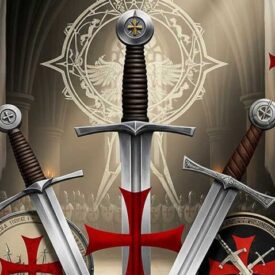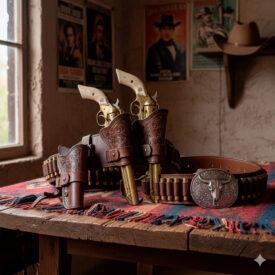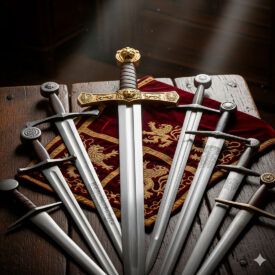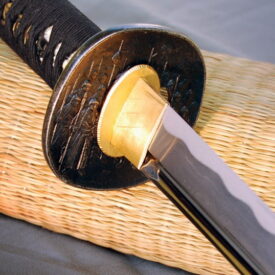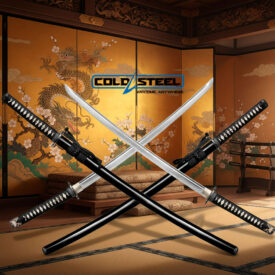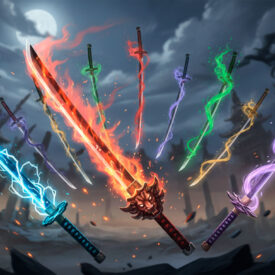Can you hear the metallic clash in the distance and the echo of prayers wielding steel and faith? The image of the crusader with his sword raised crosses the collective imagination: not just a weapon, but an emblem of mission, penance, and order. In this article, we will explore in depth the crusader’s sword: its design, its tactical use, its technical evolution, and, above all, its powerful symbolism that made it much more than a simple instrument of battle.
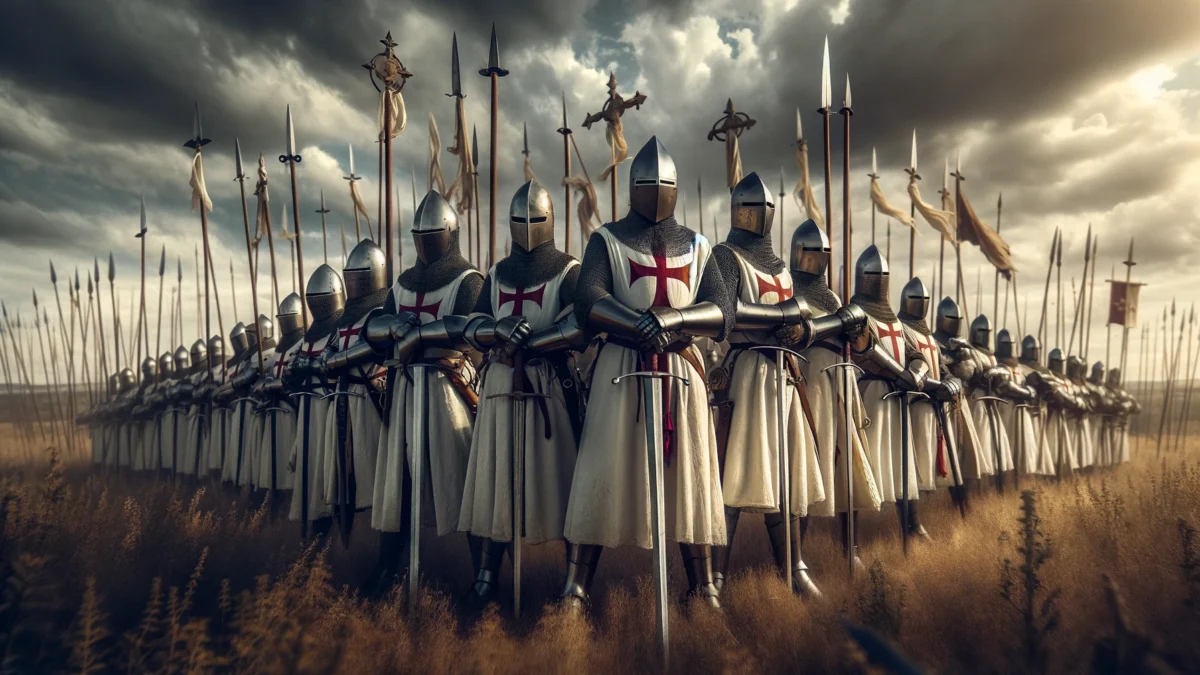
The Blade and the Cross: What do we mean by “Crusader Sword”?
When we say “Crusader sword” we refer to the typology of swords used by Western knights during the Crusades (11th-13th centuries), especially by military orders such as the Templars and Hospitallers. These blades shared functional features: double-edged, straight blade, one-handed grip, and a pommel that balanced the blade. But behind the design there was an intention: the sword had to be effective in combat, simple in appearance, and symbolically aligned with the bearer’s religious mission.
Weapons in Context: Did all Crusaders carry swords?
No. Swords were expensive. Many combatants in the expeditions did not own a blade: infantry soldiers used spears, axes, or more economical weapons. The sword was primarily a weapon for knights and men of means. Nevertheless, its presence in banners, rituals, and the insignia of the orders made it the most recognizable icon of the crusading enterprise.
The Timeline of Templar Swords: Use, Evolution, and Symbolism
| Era | Event |
|---|---|
| 11th Century (beginning) | The Order of the Temple began its activity. Swords, though not standardized, were the main weapon for knights; however, due to their cost, many low-ranking soldiers preferred spears and axes. |
| Late 11th – Early 12th Century (First Crusade, c. 1096-1099) | A period of transition in which sword and armor evolved together. Generalized blade typology (Oakeshott):
Although the spear was the primary weapon of the mounted knight, the sword was fundamental in ground combat and assaults on fortifications, effective against lightly armored enemies. |
| 1128 | Saint Bernard of Clairvaux adopted the motto taken from Psalm 115: “Not to us, LORD, not to us, but to your name give glory,” which influenced the Order’s spirituality. |
| 1129 (Council of Troyes) | The Templar Rule drafted by Hugh of Payns (72 articles) was approved. The Rule did not specify the exact design of the sword but required each friar to receive regulation equipment with quality standards; it is suggested that swords should be suitable for both mounted and foot combat (saddle sword). |
| 1130 | Expansion of the Gothic style in Europe, especially in Cistercian abbeys linked to Saint Bernard. Speculation exists about symbolic influences related to Solomon’s Temple; the octagonal Templar chapels refer to this iconography that unites the material and spiritual worlds. |
| 13th Century | Revisions of the Templar Rule: incorporation of ecclesiastical and military hierarchy canons, new sanctions, and modifications to admittance into the Order. |
| Mid-13th Century (c. 1240 and later years) | Documents attributed to Roncelin du Fos mention secret statutes like the “Baptism of Fire,” indicating internal esoteric practices. Their authenticity is debated, but they point to the existence of an inner circle with special knowledge. Roncelin held positions between 1242 and 1278; in 1266, Thomas Bérard called him “VENERABLE ULTERIOR AND SUPREME MASTER,” suggesting a hidden role. |
| Late 14th Century | Dissolution of the Order of the Temple. |
| Post-dissolution | Many decorations attributed to Templar swords (red crosses, the Templar “T,” etc.) appear to be later additions to enhance mysticism; original swords were generally sober and functional. |
| Symbolism Associated with the Templar Sword | |
| Religious and Ritual Significance | The sword was also conceived as a “weapon of light” against evil, symbolizing the word of God, authority, and spiritual power. Its double edge represented dualities (creation/destruction, alchemical processes), the axis symbolized balance and immutability, and the hilt was assimilated to the cross as a defense of faith. It was used in rites of passage and initiation and, at times, was attributed with thaumaturgic powers, especially when it contained relics in the hilt. |
Blade Types and Typologies: Understanding Form According to Combat
The Oakeshott typology helps us classify swords from the High Middle Ages and the Crusades period. Its categories reflect practical solutions: wider shapes for cutting, narrower for thrusting, fullers to lighten the blade or reinforce thrust.
| Type (Oakeshott) | Period | Shape and Use | Advantage |
|---|---|---|---|
| Type X/Xa | 10th-11th Centuries | Wide blade, robust section; good for cutting and heavy blows. | Durability and impact in hand-to-hand combat. |
| Type XI | Late 11th – 12th | Longer and thinner blade; balance between cutting and thrusting, adapted for mounted combat. | Better reach and mounted versatility. |
| Type XII | 12th Century | Sharp blade with a short fuller to increase thrust and cut. | Effective in assaults and confrontations with light armor. |
How War Influenced Design
Combat in the Holy Land demanded mobility, heat resistance, and confrontations against Eastern tactics and weapons. Crusaders adapted equipment and, through cultural contact, incorporated improvements in metallurgy and blade shapes. Cavalry charges remained decisive, but fighting in cities and sieges made the sword, versatile in the hands of the knight, crucial.
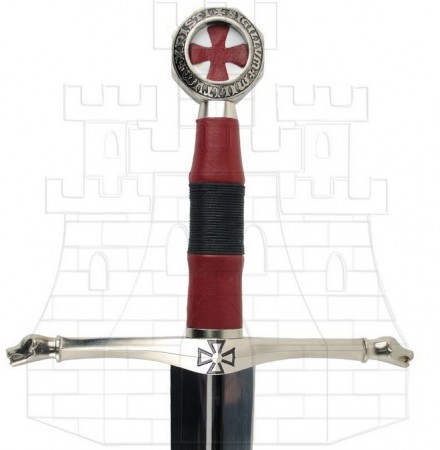
The Templar Sword: Austerity, Rule, and Function
The Rule of the Temple did not draw an ornamental pattern for the sword, but it did set equipment standards. The Order prioritized uniformity, humility, and effectiveness. A friar’s sword was functional, with a straight or slightly spatulated guard (resembling a cross) and a simple pommel.
The sober appearance was deliberate: the absence of adornments underscored the warrior’s monastic condition. In contrast, more elaborate decorations may have been added later to confer a mythical aura to specific pieces.
Symbolism and Ritual
Beyond its warlike use, the Templar sword performed symbolic functions: in ceremonies and investitures, it was seen as an instrument connecting with divine will. It was understood as a “weapon of light,” a metaphor for the war against moral and spiritual darkness.
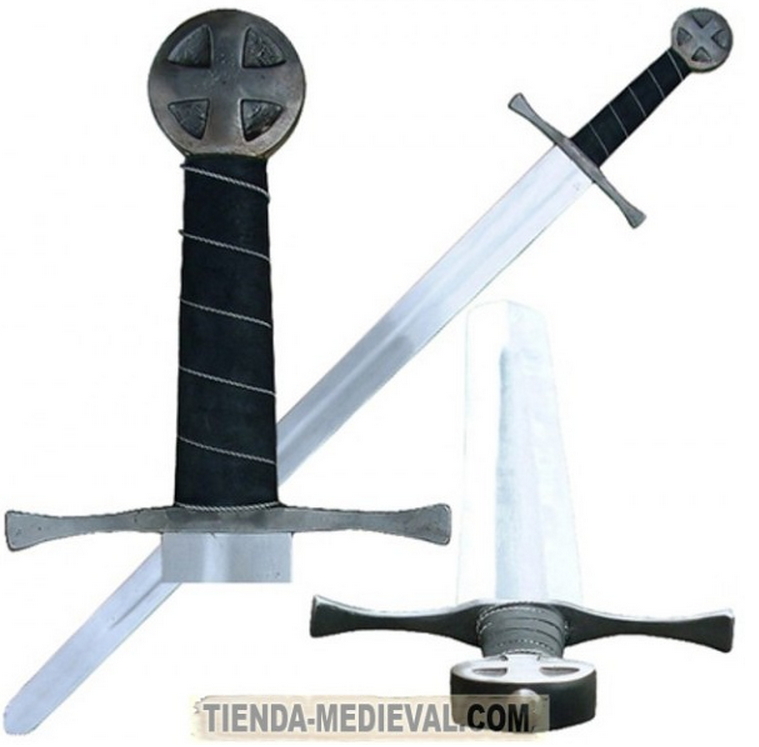
Materials and Forging: Steel, Damascus, and Intercultural Knowledge
Forging techniques in the High Middle Ages varied by region. Legendary Damascus steel, prized for its combination of hardness and flexibility, stimulated European attempts to replicate it or import sheets and patterns. Contact with the Islamic world led to the transmission of metallurgical knowledge that influenced the quality of European blades.
The manufacturing of a sword involved selecting steel forges with the correct temper, preparing the fuller or groove, adjusting the guard, and riveting the pommel. Quality determined whether a sword could be repaired in campaign, its resistance to fractures, and its balance, essential for the warrior’s effectiveness.
Life on Campaign and Maintenance
A well-maintained sword survived long campaigns; a neglected one would warp or break. Crusaders learned simple maintenance techniques: rust cleaning, sharpening, and hilt adjustment. Leather scabbards protected the blade during travel, although the Middle Eastern climate accelerated corrosion if constant care was not provided.
Replicas, Modern Use, and the Imprint of Legend
Today, the crusader sword lives on in replicas, ceremonies, and historical reenactments. Some modern pieces aim for historical fidelity; others emphasize aesthetics for ceremonies or decoration. Contemporary demand blends historical interest with the powerful symbolic charge that military orders treasure in collective memory.
Popular Replicas and Representative Pieces
Observing current replicas, you’ll notice a wide range: from lightweight swords for ceremonies to functional carbon steel replicas designed for reenactment. Each replica tries to balance aesthetics, history, and function.
Elements to Evaluate in a Replica
- Blade Material: stainless steel vs. carbon steel; each has advantages depending on use.
- Hilt and Balance: the grip affects maneuverability and realism in reenactment.
- Finish and Decoration: from sober and functional to highly ornamented; attention to historical authenticity.
Tactics and Scenarios: How the Sword Was Used in Battle
In open combat, the mounted knight relied on the spear for the initial charge. The sword intervened in the disorder after the charge, in assaults on walls, hand-to-hand combat, and in defense when the spear was no longer viable. In sieges and city fights, the sword’s versatility made it a decisive weapon.
Common Strategies
- Cavalry Charge: initial impact with spear; sword drawn to clear the subsequent chaos.
- Wall and Gate Combat: thrusting and cutting in confined spaces, using the sword to clear a path among adversaries.
- Individual Duel and Ceremony: the sword was a symbol of status and strongly linked to the knight’s identity.
Comparative Table: Historical Sword vs. Modern Replica
| Attribute | Historical Sword (11th-13th Centuries) | Modern Replica |
|---|---|---|
| Material | Period forged steel, varied | Treated carbon or stainless steel |
| Decoration | Sober, few decorations in orders | From sober to highly ornamented |
| Function | Real combat and ritual symbolism | Reenactment, ceremony, display |
The crusader’s sword brings together the practical and the sacred: an instrument of war, a symbol of order, and a tool of inner transformation for those who wielded it. Its form responds to the needs of combat and the economy of the time; its meaning transcends technique to touch the spiritual dimension of the knight-warrior.
Recognizing the sword as a technical and cultural object allows us to better understand the complexity of the Crusades: not just military campaigns, but undertakings with a religious, social, and symbolic charge that left their mark on material history and collective imagination.
